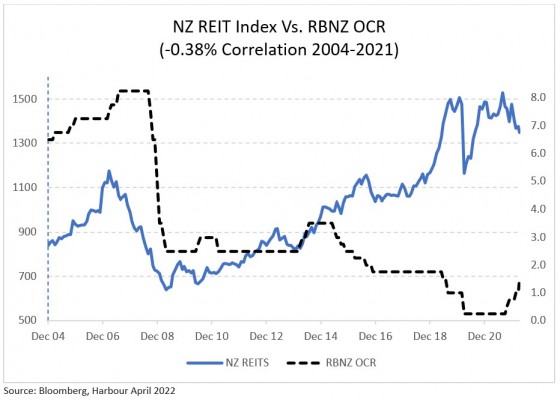- While listed real estate returns may struggle early in central bank interest rate cycles, historically they have performed better as rate hike cycles mature
- REITs have the potential to offset the impact of higher borrowing costs with higher rents over time
- Investing in REITs is not just about generating real income but also long-term, low volatility capital growth
Real Estate Investment Trusts and Securities (REITs) are assets listed on public markets that provide an efficient way to gain a diversified exposure to real estate’s longer-term, low volatility growth characteristics. It’s a common misconception that REITs underperform when interest rates rise. History suggests while REIT returns tend to struggle early in central bank interest rate cycles, REIT returns tend to perform better as rate hike cycles mature. This difference in performance partly reflects rotation in ownership from yield-focused investors to investors focused on total return and inflation protection.
As interest rates rise, the higher cost of borrowing means investors need a higher return, called “capitalisation rate expansion” (the interest rate used to discount future cashflows), to invest in commercial real estate assets. All else being equal, as capitalisation rates increase the value of REITs will go down.
However, all else is not equal. REITs tend to be an inflation hedge. Interest rate increases often reflect higher price inflation, and many REITs can offset the impact of higher capitalisation rates with higher rents over time. Most leases include fixed annual rental increases (which can’t go down) or Consumer Price Index (CPI)-linked rental increases, which means rent revenue will increase. Higher rental income offsets other rising costs, particularly where debt levels are appropriate and debt funding is well-structured. This ability to gain inflation-linked rental growth can sustain earnings growth available for distribution. The REIT investment universe is more diversified than was the case even five years ago with REITS now including investments in sectors such as logistics, healthcare and education which have structural tail winds, providing growth opportunities not available in traditional sectors such as office and retail mall assets.
Figure 1: REITS ... more than office & retail 
Source: Goodman Group, Vital Healthcare, Arena
Many investors consider REITs as yield stocks that enhance overall portfolio income yield. Over time, REITs are a relatively stable way to generate income. In New Zealand, many Entitles (PIEs) and may provide an attractive after-tax source of income.
As interest rates rise, income-focused investors need to own less REITs to meet overall portfolio income targets. In our opinion, a pure yield focus considers REITs in a narrow context. For investors looking at REITs to deliver long-term, low volatility growth – to capture earnings growth as economies shift and grow and real estate goes along with it – short term moves in interest rates have less impact. In fact, as interest rate increases hit earnings of more cyclical sectors (for instance housing and consumer-related stocks), the defensive nature of REIT earnings is reinforced.
In six of the sustained periods of rising interest rates that have occurred since the early 1970s, U.S. REITs earned positive total returns in four of them[i]. In three out of the six periods, U.S. REITs outperformed the broader S&P 500 stock market index. If interest rates are rising due to strength in the underlying economy and inflationary activity, stronger REIT fundamentals may very well outweigh any negative impact caused by rising rates.
Locally REITs have shown a modest negative correlation (rates up, REIT returns down) with Reserve Bank of New Zealand (RBNZ) official cash rates (OCR). As shown in figure 2, REITs can decouple from OCR movements suggesting other factors such as inflation, economic growth, physical commercial property supply and demand factors, and the nature of commercial property leases may influence REIT returns. The research slow shows when there are stable OCR periods, New Zealand REITs tend to deliver positive returns.
Figure 2: New Zealand REITs have shown a modest negative correlation with the RBNZ OCR 
Gearing (debt levels) and underlying physical property quality are the key influences of returns for individual REITs through the cycle. REITs with higher gearing or poorly structured debt facilities will face a higher impact from rate increases. Better quality property assets are likely to sustain income (due to less risk of empty space that is paying no rent) as more cyclical parts of economies slow with rate hikes. In a post-pandemic world, uncertainty around office and shopping mall demand remains elevated. Against this, new supply levels are low and asset pricing reflects this uncertainty. History suggests that, over the medium term, space usage may get back to pre-pandemic levels as diseases become endemic and countries re-open. Importantly the REIT investment universe is more diversified than was the case even five years ago with REITS now including investments in sectors such as logistics, healthcare and education which have structural tail winds.
In Harbour’s view, REITs are more akin to “hard assets”, and hard assets tend to perform better than cyclical assets in volatile and uncertain markets. REITs tend to get hit early in a rate hike cycle and can perform well over long periods of time if the assets are underpinned by structural demand. This reinforces the need to invest in a diversified portfolio of REITs and other hard asset REIT-style stocks with structural tail winds that can ride through the cycle.
[i] Orzano and Welling, S&P Dow Jones, July 2017
IMPORTANT NOTICE AND DISCLAIMER
Harbour Asset Management Limited is the issuer and manager of the Harbour Investment Funds. Investors must receive and should read carefully the Product Disclosure Statement, available at www.harbourasset.co.nz. We are required to publish quarterly Fund updates showing returns and total fees during the previous year, also available at www.harbourasset.co.nz. Harbour Asset Management Limited also manages wholesale unit trusts. To invest as a Wholesale Investor, investors must fit the criteria as set out in the Financial Markets Conduct Act 2013. This publication is provided in good faith for general information purposes only. Information has been prepared from sources believed to be reliable and accurate at the time of publication, but this is not guaranteed. Information, analysis or views contained herein reflect a judgement at the date of publication and are subject to change without notice. This is not intended to constitute advice to any person. To the extent that any such information, analysis, opinions or views constitutes advice, it does not take into account any person’s particular financial situation or goals and, accordingly, does not constitute financial advice under the Financial Markets Conduct Act 2013. This does not constitute advice of a legal, accounting, tax or other nature to any persons. You should consult your tax adviser in order to understand the impact of investment decisions on your tax position. The price, value and income derived from investments may fluctuate and investors may get back less than originally invested. Where an investment is denominated in a foreign currency, changes in rates of exchange may have an adverse effect on the value, price or income of the investment. Actual performance will be affected by fund charges as well as the timing of an investor’s cash flows into or out of the Fund.. Past performance is not indicative of future results, and no representation or warranty, express or implied, is made regarding future performance. Neither Harbour Asset Management Limited nor any other person guarantees repayment of any capital or any returns on capital invested in the investments. To the maximum extent permitted by law, no liability or responsibility is accepted for any loss or damage, direct or consequential, arising from or in connection with this or its contents.
